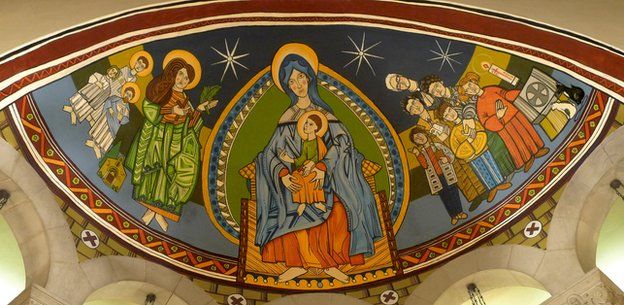The church dome painted by graffiti artists
- Published

The attempt to sell a Banksy mural taken from a London street at a Miami auction house - until it was withdrawn this week - shows that graffiti is no longer viewed simply as an urban blight. But it's still not often that graffiti artists are let loose in a church.
Spanish graffiti artist Raul Sanchez Araque, also known as House, has a varied portfolio of work under his belt - including spray-painting the outside of a sex shop and countless works of old-school guerrilla graffiti.
But it was a surprise when he was contacted by a priest at the Santa Eulalia church in l'Hospitalet, near Barcelona.
Could he, House, and fellow "graffitero" Rudi, paint a neo-Romanesque church? Specifically, the ceiling of the dome above the main altar?
As in many Catalan churches, the decoration is austere. The walls are painted nondescript colours, the statues of Jesus, the Virgin Mary and the saints are simple.
To compensate, Father Ramon Borr decided to make the main dome a little different.
"Even though the press is scandalised by graffiti artists, for me graffiti is just another artistic technique," he says.
There were practical considerations behind his choice too - quote after quote from traditional artists had come in well over budget.
He was a little tentative to start with. "I said we need to have sober colouring," begins Father Borr. "But they said, 'Look, let us try with brights and if you don't like it, we'll take it off.'"
It took his two graffiti artists 10 days and one frantic all-nighter, as they rushed to finish it for a wedding.
The result is a spectacular splash of colour - rich blues, bright reds and greens, on the dome of the church.
But don't think street art. In fact, the style of the painting is faithfully Romanesque, with static, two-dimensional renderings of Saint Eulalia, the Virgin Mary and baby Jesus, and the congregation.
"I told them they couldn't start until they visited a museum in Barcelona to study the Romanesque style I was interested in," Father Borr says. "So they went, and studied, even took out some books."
Only then did the spray cans come out.
House, 34, works full-time as an artist, doing a mix of commissioned works, for which he is paid, and what he calls his "personal graffiti", splashed on walls across Alicante where he lives. For the latter, he has been arrested numerous times.
When Father Borr hired him he was surprised, and thrilled, and nervous.
"Only a graffiti artist can tell we used aerosol cans to do the work," House says. "We tried to conceal that. In the Roman period, spray paint obviously didn't exist."
Not that House completely conformed, with the Father's wishes.
If you look carefully at the figures in the congregation, you see an elderly woman passing a thimble to a young boy. That woman was House's grandmother, a keen seamstress, who, he says, was miraculously cured of a fatal spinal disease in the 1950s.
House says he is not religious in the traditional sense, but he doesn't think that matters.
"Even if you don't believe in God, you can believe in the good will of people."
Father Borr says he's happy the artists personalised the work. And he's considering getting House, Rudi and their spray paints back to decorate more of his church, some of which dates from the Middle Ages, and some from 1957. Anything to bring more people in.
"As Pope Benedict XVI has said, art should attract the faithful."
In a bar just around the corner a group of non-church-going men are enjoying beers after work. They've never seen the dome, but are impressed by photos.
Then a man at the far end of the bar speaks up.
"I've seen it," he says. "I saw it in the newspaper, and went to check it out. It's beautiful."
"You guys ought to set your drinks down for once and go on over," he yells to the others. "It wouldn't hurt you to spend a little time in the house of God."
Gerry Hadden is Europe correspondent for The World - a co-production of the BBC World Service, PRI and WGBH